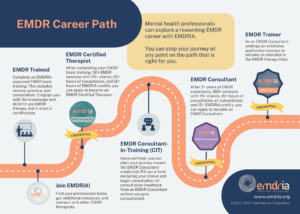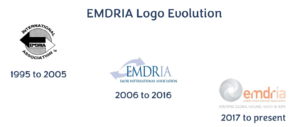If you’re reading this, you likely know that EMDRIA (the EMDR International Association) is a membership organization of EMDR therapists passionate about EMDR therapy. EMDRIA’s vision is “to foster healing, health, and hope by defining, disseminating, and promoting standards and innovations in EMDR therapy.” But maybe you are curious to know more.
The beginning of the EMDR International Association
ASAE, the Center for Association Leadership, states that “a sense of community coordination is at the heart of the association profession.” Associations help members who wish to work together toward a common cause. EMDRIA is no exception. The EMDR International Association was founded in 1995 to fill the need for an organization that could establish and encourage integrity in the standards of EMDR therapy and help the field grow.
The founder of EMDR therapy, Dr. Francine Shapiro, began to publish her seminal research on EMDR therapy in the late 80s and established the EMDR Institute in 1990 to offer EMDR training. Dr. Shapiro and key stakeholder clinicians who saw the clear benefits of EMDR recognized the need for a membership organization that could support and promote EMDR clinicians practicing EMDR. By combining the voices of EMDR therapists and setting standards for EMDR therapy, EMDRIA aimed to assist clinicians in fulfilling their responsibilities to the public as mental health professionals engaged in providing a quality psychotherapeutic service. Early EMDRIA activities were to organize and promote an annual conference, to provide EMDR education, and to disseminate news in an EMDRIA Newsletter.
 Recognizing the need for a pathway to advance clinical skills
Recognizing the need for a pathway to advance clinical skills
As the organization grew, another need was recognized. Clinicians voiced the need for a clear pathway in which trained EMDR therapists could gain advanced knowledge and skills. In 1999, EMDRIA began the certification program to help fill this need. Although it started as a 501(c)(3), EMDRIA transitioned to a 501(c)(6) organization in 1998 to better align with this goal of offering a credentialing pathway for EMDRIA members. The credentialing path outlines the possible trajectory of a clinician who becomes EMDR trained, joins EMDRIA, becomes an EMDR Certified Therapist, an EMDR Consultant-in-Training (CIT), an EMDR Consultant, and finally, an EMDR Trainer.
View the EMDRIA Career Path here: www.emdria.org/resource/emdr-career-path/
EMDRIA leadership and membership growth
EMDRIA was originally managed by an Association Management Company in Arizona from 1995 through 1996. In 1997, the organization hired its first Executive Director (part-time), Carol York. York had a private practice in Austin, Texas, and Austin became the organization’s first home. There were just three staff members in 1997, growing to six by 2004. Scott Blech was hired as EMDRIA’s first full-time executive director from 2004-2012, and Mark Doherty succeeded him as third executive director from 2012-2017. In 2017, the board of directors hired Michael Bowers as EMDRIA’s fourth executive director, and since that time, the staff has grown from 9 to 15.
EMDR therapy has gained credibility as clinicians and clients experience its effectiveness in research and practice. As the popularity of EMDR therapy has grown, EMDRIA membership has also grown. EMDRIA was excited to reach 5,000 EMDR therapist members in 2012 and 10,000 in 2020. Staff, including EMDR therapists, have been hired to meet the increasing needs of a growing membership, which reached 15,000 members in 2023.
EMDRIA programs and services over the years
Shortly after the certification program was launched, initial training standards were created, a pathway for continuing education was created with the EMDRIA Credit Program, and the first EMDRIA website was launched. Other notable membership benefits were the first Find an EMDR Therapist Directory launched in 2001 and the Journal of EMDR Practice and Research, which began publication in 2007.
Member benefit resources such as events, content (brochures, newsletters, presentation packets, etc.), networking opportunities, training curriculum standards, and continuing education events have taken different forms.
Events and continuing education
Events were at the forefront of EMDRIA’s founding activities. The first EMDRIA Conference was held in 1995, the same year EMDRIA was formed. There has been an annual EMDRIA Conference every year since. 2015 through 2019 included live-streaming of the in-person events. In 2020, the coronavirus pandemic provided the opportunity to pivot this annual in-person event into a virtual event. Attendees in 2020-2022 shared an appreciation for the virtual conference format and a longing to get back together for those who enjoyed the camaraderie of in-person gatherings. So, in 2023, EMDRIA began offering two events a year: virtual and in-person. Consultant Day and Trainer Day events, both in-person and virtual, have also been added to the annual event schedule.
Standards for EMDR Basic Training, EMDR Training Policies and Procedures, and EMDRIA’s definition of EMDR were developed over time and continue to be revisited to incorporate best practices and the latest knowledge in the EMDR field. The EMDRIA Credit program was initiated in 1999 for EMDRIA Certified Therapists to accrue the required 12 hours of EMDR continuing education for the credential. The EMDRIA Credit Program fills the need for trained EMDR therapists seeking specialized continuing education in EMDR therapy. EMDRIA OnDemand was launched in 2015 to create more continuing education opportunities.
Marketing and networking
One of the most popular member benefits is EMDRIA’s Find an EMDR Therapist search. The first Find an EMDR Therapist Directory was set up in 2001, and this directory has also seen many versions and formats. Another update from the early 2000s listserv, the EMDRIA Online Community, was launched in 2016 to provide an outlet for trained EMDR therapists to connect with other colleagues on EMDR therapy topics.
One of EMDRIA’s goals is to build an inclusive community that supports everyone, including individuals who might benefit from support due to systemic inequities. The Racial Equity Support Initiative (RESI) was launched in 2023 with the goal of increasing the number of BIPOC individuals seeking leadership roles in EMDR.
EMDRIA Digital Badges were rolled out in 2020 in response to requests for a way to celebrate, validate, and share the EMDRIA credentials.

Content and resources
The EMDRIA Newsletter, launched in 1996, has also grown and morphed. Today, the Go With That Magazine™ publication highlights articles written by practicing EMDR therapists and focused on clinical skills and practice. Other member benefits include access to clinical practice resources like EMDR Therapy Toolkits and EMDR Therapy Brochures. Members can link to the Intro to EMDR Therapy Video and have access to a PowerPoint presentation on EMDR therapy to use with colleagues. Beginning January 1, 2025, the Journal of EMDR Practice and Research (JEMDR) will be published by the American Association for the Advancement of Science (AAAS). The AAAS’ Science Partner Journal’s (SPJ) program will allow open-access scholarly peer-reviewed research that can advance EMDR therapy in policy and research discussions.
The public-facing Focal Point Blog, started in 2019, features posts on hot-button issues, awareness months, EMDRIA members as guest contributors, and In The News posts. The Let’s Talk EMDR Podcast was launched in 2022, featuring “EMDR therapists and innovators who discuss protocols and treatment approaches to treating trauma.” The EMDRIA Library, launched in 2024, is a long-awaited one-stop shop for all the above resources. It is a digital content hub that is a work in progress as the field grows and expands. Learn more about the EMDRIA Library here.
What EMDRIA has to offer
To date, EMDRIA has over 16,000 members. EMDRIA’s purpose is to promote, foster, and preserve the highest standard of excellence and integrity in EMDR practice for the EMDRIA membership, the mental health professions, and the community served. EMDRIA values diversity, encouraging inclusion and mutual respect for the multiple perspectives that foster a climate of understanding of the interdependence of multicultural humanity within our profession and in members’ service to the community. EMDRIA recognizes and supports four themes as focal points for the organization and membership:
Inclusive Community – Members belong to a community of practitioners that is global, local, online, and intimate. Members represent the diversity of those we serve (e.g., race, ethnicity, culture, disability, LGBTQ+, etc.) and special interests are embraced, supported, and nourished.
Professional Development – EMDRIA is a safe space for members to learn, access resources and expertise, collaborate, discuss, find best practices, gain professional development, and grow their community of practice. The EMDRIA community helps members build confidence in their practice and enthusiasm for EMDR.
Clear Pathway – New members are on-boarded into the organization in a way that helps them understand the resources available and gives them immediate connections to others. EMDRIA works to help members understand the pathway from training through certification to leadership in the field and in EMDRIA.
Credibility and Clout – EMDRIA is the resource for all things EMDR. EMDRIA provides transparent plain language material on our website so the public can better understand EMDR. EMDRIA has resources available for members to explain EMDR to others. Being an EMDRIA member increases members’ professional standing among peers and members are ambassadors for EMDR, actively bringing others into the EMDRIA community.
Resources
ASAE. (2024). Association FAQ. https://www.asaecenter.org/about-us/newsroom/association-faq
EMDRIA. (2023). The EMDR therapist journey: From training to certification and beyond. Focal Point Blog. www.emdria.org/blog/the-emdr-therapist-journey-from-training-to-certification-and-beyond/
Back to Focal Point Blog Homepage
Additional Resources
If you are a therapist interested in the EMDR training:
- Learn more about EMDR at the EMDRIA Library
- Learn more about EMDR Training
- Search for an EMDR Training Provider
- Check out our EMDR Training FAQ
If you are EMDR trained:
- Check out EMDRIA’s Let’s Talk EMDR Podcast
- Check out the EMDRIA blog, Focal Point
- Learn more about EMDRIA membership
- Search for Continuing Education opportunities
If you are an EMDRIA Member:
Date
July 12, 2024
Practice & Methods
History of EMDR





